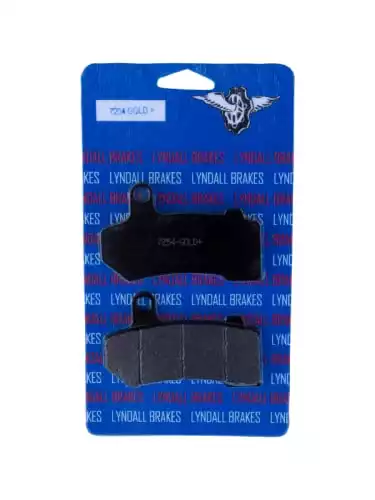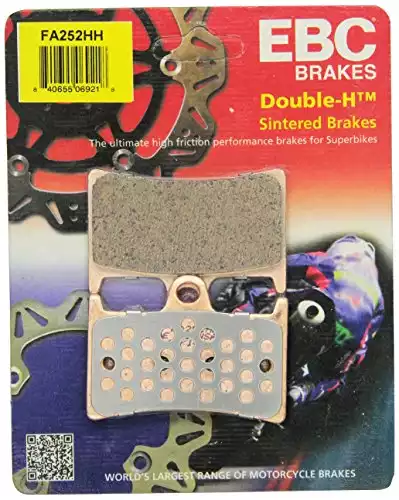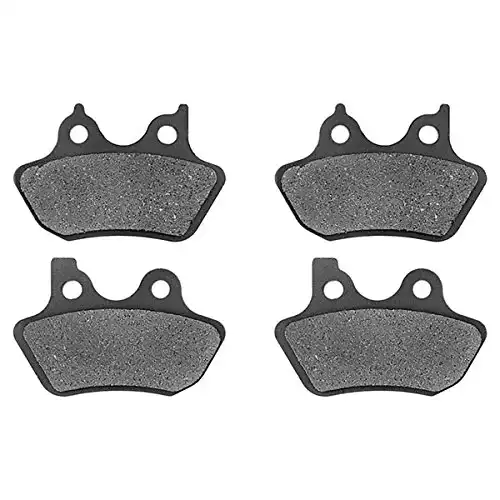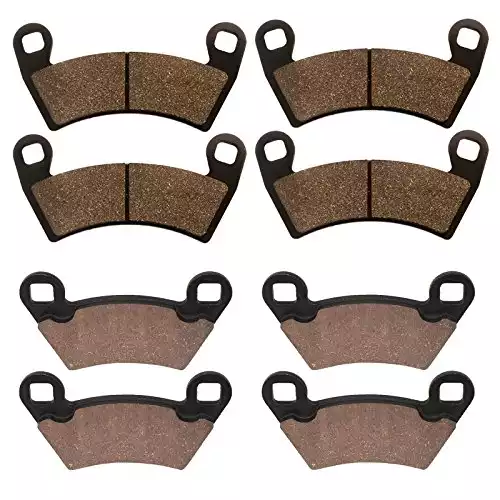Best Motorcycle Brake Pads – Ultimate Stopping Power
The best sintered, semi-sintered, organic, drum brakes, disc brakes and a whole lot more of your questions answered right here.
The two most important items on your bike when it comes to safety are tires and brakes. The first keeps you on the road or dirt, and the second stops you – literally – from smashing into objects at high speed. As important as brakes are, though, many riders tend to neglect them, and simply go for the cheapest brake pads they can get when the time comes to change pads.
Often, though, your bike is capable of stopping much faster than you realize; it’s just that the cheapskate pads you bought aren’t doing the best job of bringing your machine down from speed. To be as safe and smooth a rider as you can be, you should be using the best motorcycle brake pads you can afford.
Top Choice: EBC Brakes HH Sintered Brakes
When it comes to performance motorcycles, EBC Brakes has a reputation for making excellent, high-performance brake pads. Their HH sintered pads provide excellent stopping power.
Reviews: Best Motorcycle Brake Pads
These are what are considered to be the top motorcycle brake pads for everyday riders
Lyndall Brakes Gold Plus Brake Pads
If you want brake pads for your cruiser that do a better job than OEM Harley pads, Lyndall Brakes’ Gold Plus brake pads do a fine job of bringing your hog down from speed.
In many cases, OEM products are just find for your bike. If you’ve got a Harley, though, you can definitely improve on your cruiser’s braking performance by fitting high quality aftermarket brake pads. Lyndall Brakes’ Gold Plus brake pads provide exceptional stopping power for your Harley. They’re also low on brake dust, so your rims will stay clean, and they don’t make too much noise either. They’re not the cheapest brake pads by any means, but they do a better job than most other brake pads for your Harley on the market.
- Provide superior stopping power for Harleys
- Low brake dust
- More expensive than many other brake pads
EBC Brakes Semi-Sintered Brake Pads
Semi-sintered brake pads provide the feel of an organic pad with the endurance and performance of a sintered pad. EBC Brakes’ Semi-Sintered V-Pads Brake Pads are ideal for riders who want a balanced brake pad with great performance and endurance.
If you do a mix of performance riding, cruising and commuting on the street, and you’re looking for the blend of progressive braking feel, good bite and long operational life that good semi-sintered brake pads can offer, then EBC Brakes’ Semi-Sintered V-Pads Brake Pads might be just what you’re after.
These pads have been engineered to outlast not only most OEM brake pads, but also other aftermarket brake pads. These semi-sintered pads will bite hard but also give you progressive feedback through the brake lever, and they should last many thousands of miles. They’re not the cheapest pads on the market, not by a long shot, though.
- Provides the advantages of both organic and sintered brakes
- Great progressive feel without losing stopping power
- Engineered for great endurance and a long operational life
- Quite pricey
EBC Brakes Disc Brake Pad Set
When it comes to performance motorcycles, EBC Brakes has a reputation for making excellent, high-performance brake pads. Their HH sintered pads provide excellent stopping power.
When it comes to performance motorcycle brake pads, EBC brakes is a name that comes up often. Their HH sintered brake pads have garnered a reputation among many riders for being hard-wearing, high performance pads that they can trust to stop their bike under extreme conditions of braking, such as canyon carving and at the track. These are an ideal top choice and possibly the best motorcycle racing brake pads.
Generally, EBC’s HH sintered pads will provide way more stopping power and bite than your bike’s OEM pads will, and will work equally well in wet and dry conditions. If you’re looking to increase your sportbike’s braking performance, an upgrade to EBC HH sintered pads will likely have you smiling.
- Provide excellent stopping power
- Won’t fade even with high heat
- Pricier than many other brake pads
Caltric Front & Rear Brake Pads
There's a sense of security that comes with high-performance brake pads on a motorcycle, and Caltric Front & Rear Brake Pads provide just that.
Caltric Brake Pads offer reliable braking performance under various conditions. They're designed for durability and to reduce brake fade, a common problem with lesser quality pads. The bite is firm and consistent, providing the necessary control when needed, making every ride a safer journey.
What truly sets the Caltric Brake Pads apart is the semi-metallic composition. The composition makes them sturdy, heat-resistant, and reliable in various riding conditions, whether it's wet roads or dry terrains. Furthermore, they're also relatively quiet, thereby eliminating the pesky squeaking sounds that other brake pads often emit.
- Excellent stopping power under various conditions.
- Reduced brake fade due to the semi-metallic composition.
- Relatively noise-free operation.
- Installation can be a bit tricky for non-experienced users.
- May require a break-in period to achieve optimal performance.
EBC Brakes Water Grooved Brake Shoe
While drum brakes can experience a loss of performance in wet conditions, EBC’s Water Grooved Brake Shoe allows drum brakes to retain more bite in the wet.
Drum brakes losing their bite under wet conditions is one of the unfortunate disadvantages of this type of braking system. Thankfully, there are ways to circumvent this; by using drum brake shoes with water grooves, like EBC Brakes’ Water Grooved brake shoe, you can maintain decent braking performance even in wet conditions.
EBC Brakes’ Water Grooved Brake Shoes come with OEM style springs for easy fitment too. If you’ve got a bike with a drum brake that you frequently ride in wet conditions, whether it’s a commuter or an off road machine, these pads would be a good choice to make sure you’re able to stop safely and consistently in the wet.
- Helps drum brakes to retain more bite in wet conditions
- Good price
- Come with OEM style brake shoe springs
Best Motorcycle Brake Pad Brands
Galfer
Galfer are top notch brake pad manufacturers that have been in the business since 1946. They initially supplied brakes to the European market. Galfer made their mark on the US market in 1992. Since then, many top riders and racers from motocross to track and even Harley riders have found comfort in Galfer brake pads. Check out this article for a full review of Harley Brake Pads.
EBC
EBC brakes are one of the most popular brake pad manufacturers. They have over 5000 SKUs for just about every type of vehicle.
SBS
SBS are a key market player with a focus on brake pads for two-wheel vehicles. They continue to develop and produce high tech stopping power for street, off-road and racing bikes.
BikeMaster
The quality of BikeMaster replacement brakes offers excellent OEM quality and performance we’ve all come to know and love. They’ve been in the business since 1981 and provide a range of replacement parts from brakes, batteries, tools, air filters, grips, handlebars, chains and more.
Lyndall Brakes
Lyndall brakes are a top choice for many motorcycle enthusiasts. Trusted for their high quality and long lasting motorcycle brake components. Their trust has been earned by riders all over the world for providing some of the best aftermarket brakes and rotors for motorcycles.
How to Replace Brake Pads on a Motorcycle
Tools Needed To Replace Motorcycle Brake Pads
You’re going to need a few simple tools that can be found in just about any home garage work bench. Here’s a list of tools:
- Spanners
- Sockets or Allen keys
- Brake cleaner spray
- A rag
- Flat-headed screwdriver
- High temperature silicone grease
- Bungee cords
- Torque wrench
- Pliers
- Brake fluid
Things To Remember
If your brake pads have been poorly maintained, it’s possible that the caliper retaining bolts can seize up and using the wrong tools to loosen then can result in you having to completely replace them. Fear not. The over process of replacing your bikes brakes is fairly simple and straightforward. If you have the tools and around 2-3 hours of time, you can replace your own brake pads.
Step By Step Procedure
Writing out a step by step procedure wouldn’t be that difficult. However there are a ton of instructional step by step videos that would probably serve you better. Try this one.
Motorcycle Brake Pad FAQ’s
What Kind Of Brakes Does My Motorcycle Have?
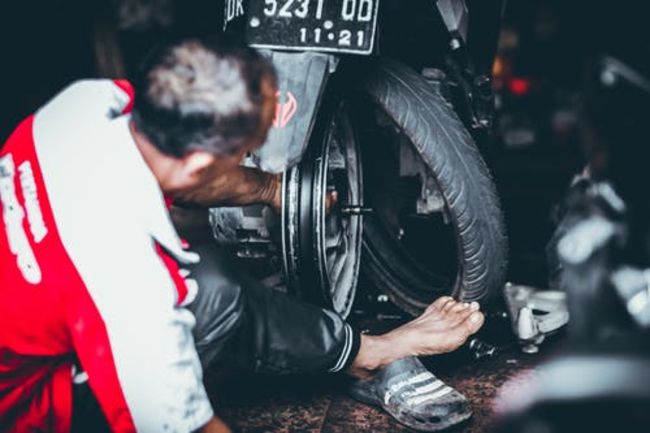
The vast majority of modern motorcycles have disc brakes up front, and usually a disc brake at the rear as well. Many larger capacity bikes, especially sport bikes and adventure bikes (as well as some high performance smaller capacity machines) almost always have twin discs up front. Cruisers, commuters and smaller bikes will usually have a single disc brake up front. Older bikes, as well as small, cheap commuters and some budget dirt bikes, will have a drum brake at the rear, or even a drum brake at the front as well instead of a disc brake
What’s The Difference Between Disc Brakes And Drum Brakes?
Disc brakes are far more effective at stopping a bike than drum brakes are. However, for many decades motorcycles only ever had drum brakes, but this started to change in the 1970s. Why did things change? To put it simply, in the vast majority of cases disc brakes provide superior stopping power. They also perform better in the wet, and stay cooler (and thus work more efficiently) than drum brakes. Disc brakes work by having pistons inside calipers squeeze brake pads against a disc, while a drum brake is located inside the motorcycle’s wheel, and works by pressing a shoe against the inside of the brake drum.
How Often Should I Change My Brake Pads?
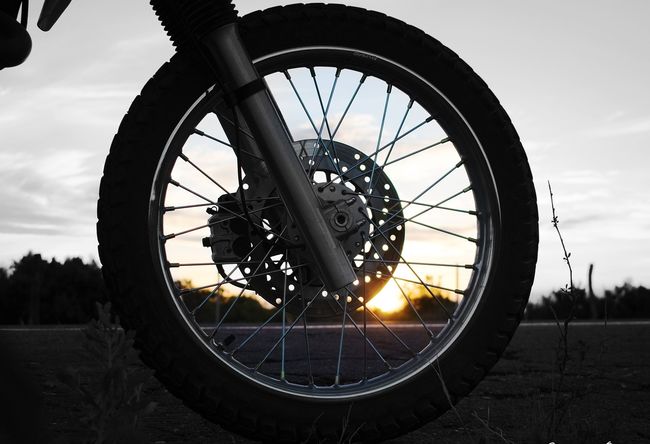
Usually your owner’s manual will tell you how often you should be inspecting your brakes. A good general rule is to check your brake pads every six months or each time you rotate your tires. More aggressive riders should inspect the brake pads more frequently or with with each oil change.
How can I tell if I need to replace my brake pads?
Checking how much life is left in your disc brake pads is quite easy. Look at the friction lining of the pads, use a torch for better inspection. If there is less than an eighth of an inch, your brake pads are worn out and should be replaced. There are plenty of detailed DIY guides to replacing brake pads online. A sure sign that the pads need to be replaced is when you start to hear squealing sounds from your brakes. Most brake pads should last about 20,000 miles.
What is the Best Material for Motorcycle Brake Pads?
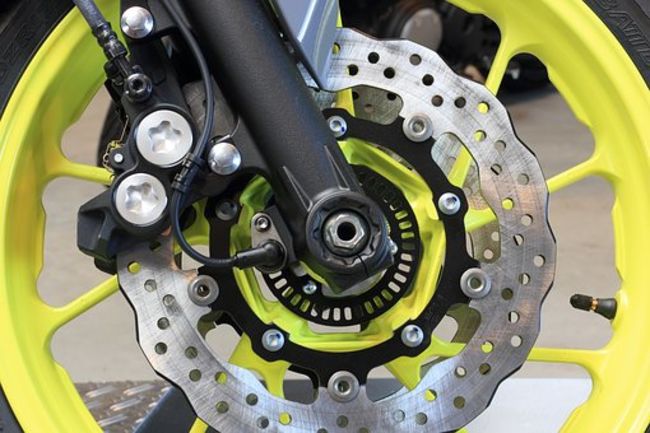
Motorcycle disc brake pads come in a variety of materials, each with their own sets of advantages and disadvantages. As with many things in motorcycling, what kind of bike you ride and how you ride it will determine what’s right for you. Some materials will provide a longer working life, allowing you to get more mileage out of the pads, while others will provide increased braking performance, allowing you to brake much more aggressively and haul your bike down from speed quickly.
Generally, motorcycle disc brake pads come in three varieties: organic, semi-sintered, and sintered, also called ceramic. On the majority of motorcycles, sintered and semi-sintered pads are standard, while organic pads are generally used on smaller capacity or commuter bikes.
Are Organic Or Ceramic Brake Pads Better?
Well, when it comes to stopping your bike quickly, ceramic (sintered) brake pads are better; they bite more sharply, and they bite strongly right away even when cold. Due to the materials used in sintered brake pads, they’re also able to handle heat very well, and retain their braking strength even under conditions of extreme heat. This is why they’re used on race bikes, performance machines, and by riders who frequently push their motorcycles really hard; a rider who is using sintered brake pads knows that his brakes will stay sharp and powerful even under the most demanding conditions.
This is not to say that organic brake pads are useless, however. They provide a softer and more gradually progressive feel to your brakes, which is useful if you’re a newer rider, or a commuter on a lower performance machine, and you don’t want to run the risk of locking your wheel up (which almost always results in a crash) by grabbing your brake lever too enthusiastically.
Another advantage of organic brake pads, particularly to commuters who rack up a lot of miles on their bikes, is that they don’t damage the brake rotors (the discs) as harshly as sintered pads do. A downside to organic pads, though, is that they tend to wear out faster than sintered pads, so you’ll need to replace them more frequently. Another disadvantage is that using organic brake pads in extremely wet conditions can lead to a loss of braking performance not to mention using the correct anti freeze and coolant.
What Are Sintered Motorcycle Brake Pads?
Sintered or ceramic pads are made by using extreme pressure and heat to fuse metallic particles and other substances to create a material that is extremely resistant to friction. This translates into better stopping power and a longer functional life than organic brake pads.
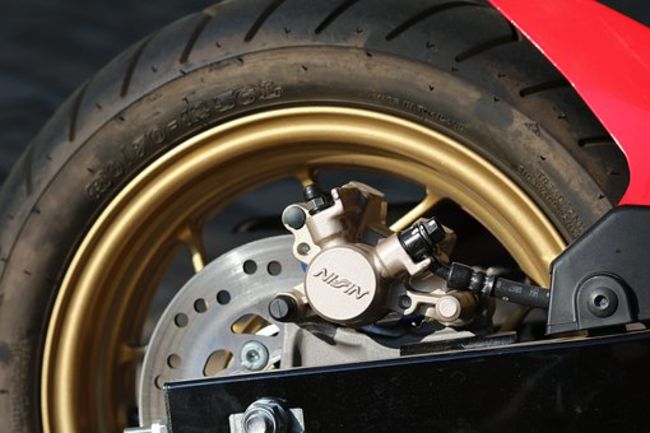
Then, in addition to sintered motorcycle brake pads, you get semi-sintered pads. These combine, in the sintering process, a number of metal particles (often copper) with a blend of the types of substances used in organic brake pads. For many riders, semi-sintered pads offer an ideal compromise between sintered and organic pads; they have the strong bite and long operational life of sintered pads, but also give the progressive feel at the brake lever that organic pads do.
Do I have to lubricate brake pads on a motorcycle?
The only products needed to clean and lubricate a motorcycle brake system is brake cleaner and high temperature silicone brake grease. The grease should be used to lubricate any pins, slides or pivot points when reinstalling the cleaned calipers. Avoid getting grease on the actual pads and rotor. It’s always worthwhile using some brake cleaner to clean the pads and rotor after replacing your brake pads. It’s also worthwhile pumping your brakes before heading out on a ride.
How Much Does It Cost To Replace Motorcycle Brakes?
Motorcycle brake pads cost around $30-$50 per wheel, depending on the type of brakes and the brand you buy. If you need to replace your rotor, this will set you back a few $100 per brake pad set. The last cost you need to account for is an hour or two of labor which varies by mechanic.
What is Brake Fade?
The term “brake fade” describes the situation where there brake pad has worn down to the extent that there is not enough brake pad making solid contact with the rotor. This results in minimal friction and a reduction or complete loss of a vehicle’s braking power.
Which Brake Pads Are Better At Reducing Brake Fade?
First up, what exactly is brake fade? Basically, this alarming and dangerous phenomenon is a loss of braking power caused by the brakes overheating. This is likely to occur if you’re really pushing your bike to the limits and braking hard at closed-spaced intervals, such as you would on a race track or high speed canyon carving, or when you’re trying to slow down a lot of mass, like if you’re taking a fully-loaded bike down a long, steep hill.
Organic pads will experience brake fade a lot sooner than ceramic pads will, so if you’re the kind of rider who frequently pushes his or her machine to the limits, does track days, hits the dirt trails hard, or often travels through difficult terrain, you’d be better off going for sintered or semi-sintered brake pads.
Last Checkpoint: The Best Brake Pads
Remember, your brakes are often the only thing standing between you and a bad accident, so you want them, perhaps more than any other component on your bike. And, you want them performing at their absolute best. For that reason I suggest the EBC Brakes HH Sintered Brakes for ultimate performance riding. The alternative choice would be the Lyndall Racing Gold Plus Brake Pads for your daily commuting.
For Info related to the topc check out these articles:

